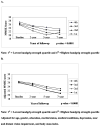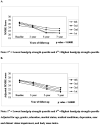Handgrip strength and cognitive decline in older Mexican Americans
- PMID: 16912105
- PMCID: PMC1635471
- DOI: 10.1093/gerona/61.8.859
Handgrip strength and cognitive decline in older Mexican Americans
Abstract
Background: Cognitive decline and dementia are associated with disability and premature death in old age. We examined whether low handgrip strength predicts subsequent cognitive decline in older Mexican Americans.
Methods: We worked with a 7-year prospective cohort of 2160 noninstitutionalized Mexican Americans aged 65 years or older from the Hispanic Established Population for the Epidemiological Study of the Elderly (H-EPESE) who had a Mini-Mental State Examination (MMSE) score > or = 21 at baseline. Measures included: (i) sociodemographic factors (age, gender, and education), handgrip strength, and near and distant visual impairment from baseline interview; and (ii) MMSE, body mass index (BMI), and medical conditions (stroke, heart attack, diabetes, depression, and hypertension) from four waves of data collection.
Results: Using general linear mixed models, we found a significant trend with scores in the lowest quartile of handgrip strength at baseline to be associated with lower MMSE scores over time (estimate = -1.28, standard error = 0.16; p <.0001). There was a significant handgrip Strength-by-Time interaction with MMSE scores. Participants in the lowest handgrip strength quartile had a greater cognitive decline over time (estimate = -0.26, standard error = 0.07; p <.001) than did those participants in the highest quartile. This association remained statistically significant after controlling for potential confounding factors.
Conclusion: Older Mexican Americans with reduced handgrip strength at baseline demonstrated a statistically significant decline in cognitive function over a 7-year period. By contrast, participants in the highest handgrip strength quartile maintained a higher level of cognitive function.
Figures
References
-
- Petersen RC, Smith GE, Waring SC, Ivnik RJ, Tangalos EG, Kokmen E. Mild cognitive impairment: Clinical characterization and outcome. Arch Neurol. 1999;56:303–308. - PubMed
-
- Butler SM, Ashford JW, Snowdon DA. Age, education, and changes in the Mini-Mental State Exam scores of older women: Findings from the Nun Study. J Am Geriatr Soc. 1996;44:675–681. - PubMed
-
- Christensen H, Jorm AF, Henderson AS, MacKinnon AJ, Korten AE, Scott LR. The relationship between health and cognitive functioning in a sample of elderly people in the community. Age Aging. 1994;23:204–209. - PubMed
-
- Reyes-Ortiz CA, Kuo Y-F, DiNuzzo AR, Ray LA, Raji MA, Markides KS. Near vision impairment predicts cognitive decline: Data from the Hispanic Established Population for Epidemiologic Studies of the Elderly. J Am Geriatr Soc. 2005;53:681–686. - PubMed
-
- Weuve J, Kang JH, Manson JE, Breteler MM, Ware JH, Grodstein F. Physical activity, including walking, and cognitive function in older women. JAMA. 2004;292:1454–1461. - PubMed
Publication types
MeSH terms
Grants and funding
LinkOut - more resources
Full Text Sources
Other Literature Sources



